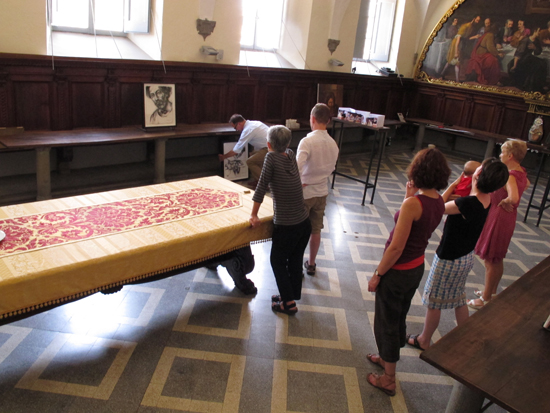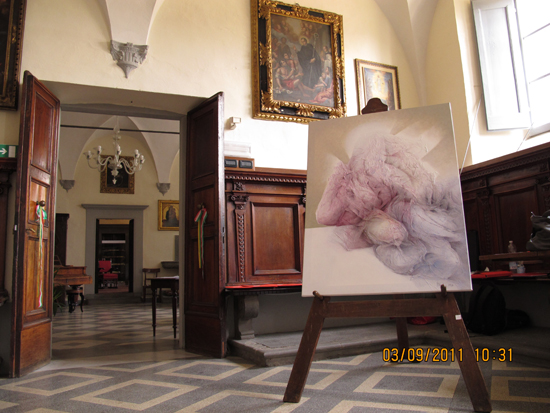Brigid's video of Judas
Installing ‘ L’Ultima Cena’: a brief description of the process- by Anne Grebby
The collection of new work, made in response to Sansoni’s ‘L’Ultima Cena’ was brought together for the first time on Friday Sept 2nd. 2011. Its diversity of size, content and media presented us with an installation challenge.
(Nothing can be attached to the Refettorio walls, so there’s no possibility of a traditional ‘hanging’. It’s dominated by the massive original painting at the far end of the space. Long tables on stone pillars run down either side of the room.)
Initially, each artist stated which would be the preferable placing for their own work. Then a nucleus group took on the job of optimising the potential for individual pieces in relation to each other and to the installation space.
We shifted the work around the room, seeing the transformations which occurred in this completely new context. The discussion was interesting and creative and the eventual solutions were arrived at with great care. Through this system of placing, each work found an appropriate position and the whole of the space was energised, for example:
Bruno Fiori’s painted column, inscribed with Christ’s inner thoughts, echoed the doorway to the room and framed the whole installation. The work established its timescale in ‘the moment’ after the last supper table had been cleared away. On the large refectory table beyond, stood the ‘reliquary’ of Mandy Havers quoting the painted head of Christ, in the distance. It cocooned a piece of bread, notionally from the last supper and welcomed the visitors with a flickering flame light bulb in its crown.
Jonathan Waller’s glowing green and red ‘Head studies’ of Sansoni were placed, facing inwards and across the space, glancing at the artist’s self-portrait staring out from the left of the Last Supper table. Next to them, Ben Cove’s ‘HERE AND NOW’ commemorative plate was placed on the table, fixing the whole exhibition in an ambiguous time layer, and echoing the past, present and future depiction in the painting.
Anne Grebby’s version of ‘L’Ultima Cena’ offered twelve views of the remains of the supper, a torn tablecloth, covered with breadcrumbs, oil and wine stains. The work was placed vertically on a table, beneath a heavy gold- framed painting, which emphasised the ephemeral nature of her wine-spattered relic and emphasised its lack of imputable worth.
The importance of the meal itself, its link with Pescia and the everyday ritual of eating together was celebrated by Graham Chorlton’s ‘Trattoria’ paintings, which were placed in the wall panels, as if opening a window on the world beyond the dining space of the Refettorio.
In Brigid McLeer’s ‘untitled Judas’ video, almost imperceptive, light passes over a photograph of the painting of Judas’ face. It existed in the ‘real’ time of the exhibition, holding the ‘past time’ of the video and conjures up the past time of the painting, recording day moving towards night, and returning to day.
Seeming to give off a light of its own, at the far end of the room, directly under ‘L’Ultima Cena’, was Bev Stout’s salt text ‘per l’amore di Dio’ . Hand- formed with absolute precision, (as if manufactured), it was hidden away, discreetly placed in the darkness beneath a table.
To the left of the painting, placed behind a table, Christ bent over to sip the cup of wine. John Devane’s portrait referenced Scorsese’s film, ‘The Last Temptation’, bringing a more humanised painted Jesus into the twentieth century.
The photographic documentation of Jane Ball’s sound work, ‘senza filo’ stood like a miniature stage set parallel to Sansoni’s painting. Around each depicted table, people were whispering. Standing in front of the piece, one picked up the quiet hum of distant voices, coming and going, travelling around a circle of microphones.
The drawing of ‘Judas’ and the ‘two hands’ which rest on the table, by Alison Lambert, was placed at a half-way point between the entrance and the painting, juxtaposed against not only the original, but also Brigid’s video image. It called attention to the ambiguity of Judas’ role.
At the next table, Alan Dyer’s ‘L’Ultima Cena’ detailed fragments of script framed a massive iron nail, as if it were a precious icon. It stood as a metaphor for the Christian narrative and at the same time a reliquary object. Placed on the table, menu-like, it offered the subtext of the plot.
On leaving the exhibition, the viewer came face to face with Claudio Stefanelli’s painting of ‘Jesus and John’, shrouded, seemingly in a semi-transparent skin. It stared back at Sansoni’s own Jesus and John figures, emphasising a sense of intimacy and evoking ideas of birth and death.
On passing through the exhibition space, everyone’s attention was repeatedly drawn back to the source. Viewers were invited to read their own meanings suggested by the work and discuss it with the artists themselves, the two translators, working on the project, Alessandra Lavoratti, Cristina Mastroeni and the exhibition Director, Amadeo Valbonese.
The two days of the exhibition were really busy and the majority of visitors wanted to talk about the show and know more about individual works. Furthermore, many people had access to the Refettorio and Sansoni’s painting, whom otherwise would never have known that they existed. | 


































